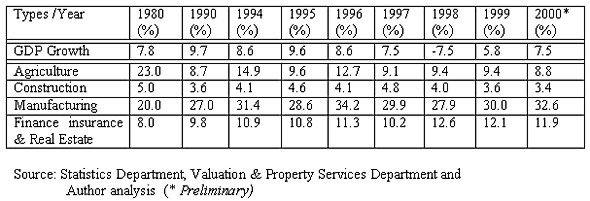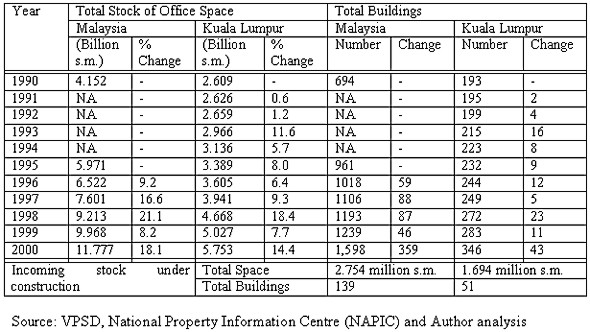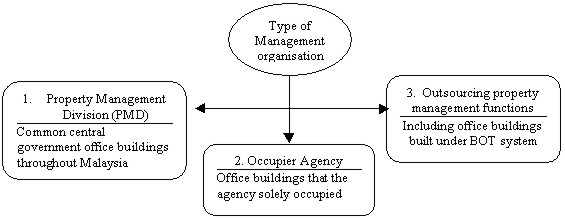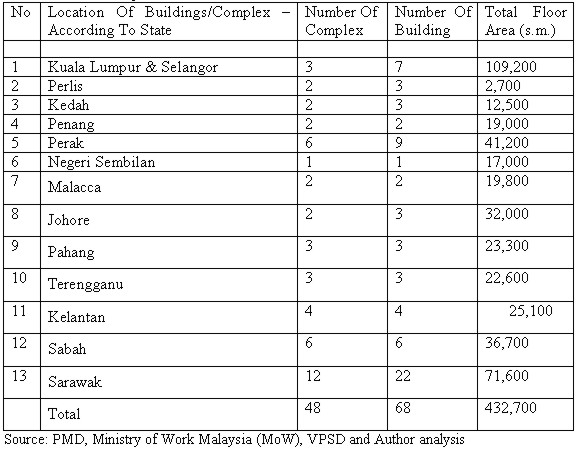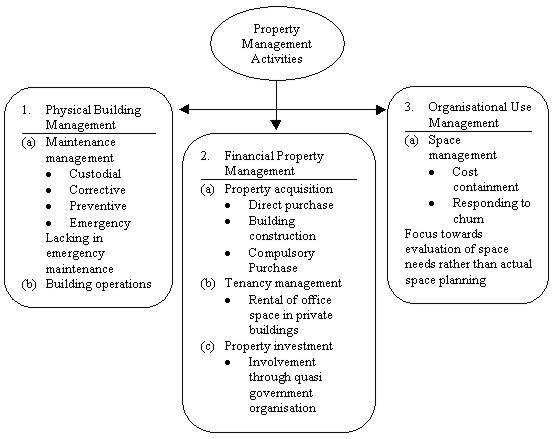THE MANAGEMENT OF PUBLIC PROPERTY IN MALAYSIAZailan MOHD ISA, MalaysiaKey words: Malaysia, property management, public sector, and property management practice. 1. INTRODUCTIONProperty assets such as land and buildings are a key resource for all types of organisations, including public sectors. For the last two decades positive effects of good property management have received increased attention as the stock of new buildings costing billions of ringgit are being put into operation. In private sector, this attention is due largely to the recognition of the significant contribution property makes to ultimate success or failure of a business and recognition of strategic importance of property to a company's financial structure. While within public sector organisations property can be considered as having financial contribution and effect upon annual financial statements, asset base and as well as on resale values in case of privatisations of any public entities. Therefore property resource, in the same way as human, financial and information resources, contribute to the success of these organisations and need to be effectively and efficiently managed. These property assets have to be professionally managed to ensure that the asset value is maintained. It is acknowledged that not only is a large amount of capital devoted to these property assets, they can also add value to an organisation through effective and often creative management. However, do public sector organisations in Malaysia recognise that property, both raw and buildings are valuable assets? Landed professionals have been calling for the need to manage public property more professionally for a long time (Dass, 1985, Marbeck, 1988, Singh, 1994 and 1996, and Mahadi, 1998). Hence, realising the importance of property to public sector organisations, this paper will discuss the functions of public property management, focusing on the management of office buildings. In doing so, this paper will explore the need for property management and discuss the management practice in public sector property management. 2. THE NEED FOR PROPERTY MANAGEMENTIn understanding the need for property management, it would be relevant to look at Malaysian economy indicator and the place of property in its economy. Before the outbreak of the Asian financial crisis in mid-1997, Malaysia experiences rapid economic growth and property sector plays a significant role in this growth. Table 1 below indicates that the Malaysian economy has performed above 7.0% with the exception for 1998. Malaysia has moved from an agro-based economy before the 1980s to manufacturing and services orientated in 1990s. Manufacturing, and finance insurance and real estate respectively contributed 30.0% and 12.1% of the economy in 1999 compared to 20.0% and 8.0% in 1980, whilst agriculture decreased from 23.0% in 1980 to 5.8% in 1999. Table 1. GDP Growth and Selected Domestic Products By Industries - Share Of GDP
From bank lending aspect, bank loans to the broad property sector including construction by commercial banks and finance companies have generally increased from RM32.6 billion in 1990 to RM127.6 billion in 2000. These economic indicators portray an expanding and growth oriented economy, which should give rise to employment, greater spatial requirements for manufacturing and production industries, service industries, as well as office and retail space and housing accommodation. Accordingly the numbers of operational property assets such as offices, industrial premises, shopping complexes, and residential and agricultural buildings have increased tremendously. In office sector, over the last decade the number of purpose-built office buildings have increased from 694 in 1990 to more than double i.e. 1,598 units in 2000 (VPSD, 2000). It can be gleaned from Table 2 that the current supply of purpose built office space is 11.77 billion square meters compared to 4.15 billion square meters ten years ago. Almost 50% or 5.75 billion square meters of this space is located in Kuala Lumpur, the capital city of Malaysia and the development of Putrajaya as the administrative city for Malaysian central government contributes 333,000 square metres of office space from 21 buildings. In the last five years office property market experiences annual increase in office space of more than 8.2%. More than 2.75 million square meters of office space from 139 buildings are expected to come into market in the next three years. Thus there is an enormous amount of office space, which has a tremendous amount of asset value in property market. These properties need to be effectively and efficiently managed, as there is significant relationship between property management and investment performance. Effective property management may reduce operating costs, dispose of excess properties, or hold on troubled properties by improving their operating income (and reducing their operating losses). Table 2. Purpose Built Office Space (1990 - 2000)
Apart from that, the importance of effective property management in public sector can be perceived in many ways. Firstly, public sector organizations in Malaysia are among the largest property owners and the richest in the term of operational property value (Ismail, 1996). Property can therefore, be considered as having financial contribution and effect upon annual financial statements, asset base and as well as on resale values in the case of privatisations of any public entities. Secondly, in the events of economic and financial crisis, effective property management in public sector would improve property performance through quality improvement and control cost. Finally effective property management deliver quality service to its end-users i.e. public sector employees. It should be noted that the federal government departments have the highest number of employees in their organizations of about 800,000 that occupy majority of their office buildings. 3. PROPERTY MANAGEMENT IN MALAYSIAWhat do property management entail? Managing property involve establishing goals, objectives and policies and implementation of strategies to achieve those goals and objectives. According to Singh, (1994,1996) property management is an activity that seeks to control interests in property taking into consideration the short and long term objectives of the property owner and particular purpose for which the property is held. From practical perspective Wong (1999) considers property management as the work carried out to manage and maintain the development including its facilities at the level that will retain or enhance the value of the development, create a safe, functional and conducive living environment for occupants, keep or restore every facility in efficient working order and in good state of repair, and project a good appearance or image for the development. In a study on the operational property management process in large non-property organisation in Malaysia, Ismail (1996) regards property management responsibility include all the necessary reporting, accounting, maintenance and decision making to ensure the economic and physical vitality of property assets. In this view the author looks at three aspects that are the management of the non-physical aspects of buildings such as legal and tenure matters, the management of physical aspects of buildings such as building maintenance and the economic management of the operational property assets, such as acquisition, disposal and development of the property assets. The core of property management may thus involve the management of the physical asset, which include maintenance; organisational use management, which include space management or user requirements; and financial management, which include property valuation, acquisition and disposal, property investment management and tenancy management. In Malaysian office sector, the public property management focus towards building operation that involves maintenance management, space management or user requirement of space and security management. Public sector organisations also undertake property valuation, acquisition and disposal, which are normally focus for development of new office buildings. As far as tenancy management is concerned, the involvement of public sector organisations is limited to the occupation of office space in private buildings. On the other hand, from property investment management aspect, the central government organisations are not involved directly but rather through quasi government organisations. It should be noted that the Malaysian public sector is defined as the central government, state governments, local governments, statutory bodies and the Non-Financial Public Enterprises (NEPE), most of which are public corporations. However, this paper will explore and discuss the current system of public sector management, which is practice in the central government. It is equally applicable to state government, local authorities and statutory bodies. 4. PUBLIC SECTOR PROPERTY MANAGEMENT ACTIVITIESAccording to Joroff (1992) there is no single best model that could suggest the type of property management activities can be organised and related to other management functions within large organisation particularly in public sector. The choice of what activities constitute property management depend mainly on the objectives property management itself, the choice of tenure and the mandate of property function. External factors may also affect the choice of property management activities (Ismail, 1996) and so does the phase of development of the organisation. For example the economic recession may bring a greater emphasis on certain types of property management activities. Expanding functions of an organisation may require acquisition, development and project management skills. As far Malaysia is concerned, there are three approaches to the current system of public sector property management activities as indicated in Figure 1 below. Firstly, Property Management Division (PMD) of the Prime Minister's Department normally manages common central government office buildings, Secondly an occupier agency manages office buildings that the agency solely occupy. Finally, outsourcing of property management functions where the outsourced company handle all the routine property level management activities.
Figure 1: Management Organisation In Public Sector Property Management In the case of common central government office buildings PMD holds the overall responsibilities on the property management aspect while the other agencies act on advisory capacity. Table 3 below shows that PMD manages 68 common central government office buildings throughout the country, which contributes close to half a million square meters of office space. At the same time PMD also has 12 projects for construction of similar buildings that are either at planning or construction stage. Table 3. Common Central Government Public Office Buildings Managed By PMD Of Prime Minister Department
In the case where an occupier agency manages the office buildings, the management of such buildings is subjected to the guidelines and rules impose by PMD. No data is available on the size of these agencies property holdings since their buildings are sited on land owned by FCLM (even though FCLM has a program known as Sistem Pemantauan Tanah Persekutuan (SPTP), it is not comprehensive to cover all aspect of property database for property management). Nevertheless under these two approaches, the public property continues to be traditionally managed in a fragmented and decentralized way. The responsibilities for property management are distributed among a number of government departments. Some property management activities are carried out in-house, some partly outsourced and the rest mainly outsourced. Finally, in the case outsourcing of property management functions, the outsourced company handle the entire routine property level management activities for example Putrajaya Administrative centre. In this instance, the whole property management activities still lie within the ambits of PMD's functions.
Figure 2. Public Sector Property Management Activities Property Acquisition Property Acquisition is the financial aspect of property management. In practice it involves direct property purchase, building construction, and compulsory acquisition or purchase of land or land alienation from state authority. The overall responsibilities lay with the PMD and FCLM while the other government agencies act on advisory capacity (The Civil Service of Malaysia, 1982). Government Property Coordinator Committee under the secretariat of PMD oversees the whole function of property acquisition.
Tenancy Management Rental of Office Space in Private Property: The Committee on Office Space under PMD deals with requests for rental space by various government agencies. VPSD undertakes the rental valuation exercise of the office space and GSD advises on the security aspects of the subject building. In practice the occupier agency make their space requirement planning and forward to the Committee for space approval after obtaining budget approval from Treasury. Space Management Space is the organisational use aspect in property management. The primary aim in space management is to make the most efficient and effective use of space, equipment and furniture, during the present time as well as in the future; and to provide an environment which enable the largest cost and most important asset of the organisation, its people to operate (Abdul Rahman, 1999). Effective space management can be discussed from two broad areas, namely cost containment and responding to churn. Cost containment requires the understanding of quality. Its objective is to provide the best possible support for the full range of activities critical to organisational survival, at lowest possible cost, over an expected period of use. Churn is the direct result of organisational change and office churn is the relocation of an individual or groups of individuals resulting in a change to the office environment. In this context, the main purpose of space management is to reduce the amount of space needed to carry out a certain functions whilst at the same time improving the quality of facility. Successful changes have redistributed space from workplace to support function, often accompanied by improved management of communications, data handling and more comfortable formal and informal meeting areas. There are various ways and means by which the organisation undertakes to make the most efficient and effective use of space, equipment and furniture. It may be, open plan, redistribution of space, the non-territorial office, charge-back systems, looking at quality in terms of it, panel-based open planning, fixed service spine, universal plan office and the loose fit approach to design. In Malaysia, public sector adopts open plan concept with panel-based open planning and implements space standards. The space standards are detailed and rigidly enforced as part of the conditions of property budgeting approvals. It emphasises hierarchical differences in rank between employees, where senior officers are allocated large amount of spaces for the purpose of status distinction. In practice, the property responsibility under space management is more focus towards evaluation of space needs rather than the actual space planning. Maintenance Management Maintenance Management is the physical aspect of property management. According to Othman (1996) maintenance management is a management system, or procedure, designed to allow buildings owners or managers to look after their buildings in an efficient, well organised and cost effective manner. In other words, the maintenance manager combats the effect of physical deterioration in an attempt to maintain the premise at the level comparable to its initial condition. Therefore maintenance management covers most of the buildings operations and maintenance function. Maintenance of physical asset is an ongoing process, which can be broken down into four main categories (Brown, 1993, p. 428).
As far as common central government office buildings are concerned, under the supervisions of Ministry of Works (MoW), PMD outsource building maintenance support service according to zone except for those buildings located in Selangor and Kuala Lumpur. The Ministry plans, manages and monitors the outsourced property management work with the help from Building Maintenance Support Service Committees set at up at various affected buildings. PWD carries out buildings maintenance works of office buildings in Selangor and Kuala Lumpur. In the case of an occupier agency manages the office buildings, major maintenance works are outsourced through tender boards and smaller works through quotations sub-committees. Minor technical matters are managed by the organisation with the advice from PWD. Major technical matters are handled directly by PWD. A part from that, a small number of technical staffs is retained within the occupier agency to monitor the outsourced property management work. Managerial staffs within the agency plan and manage the other property management activities. It has to be mentioned that where government agency acquire property through "build, occupy and transfer" (BOT) concept, the entire maintenance management of the subject buildings are also outsourced. 5. THE ISSUE OF PUBLIC SECTOR PROPERTY MANAGEMENT AND COMMENTS5.1 Management ProcessAs mentioned in the foregoing, the responsibilities for property management are distributed among a number of government departments. Public sector property is often managed in a reactive manner. The work is driven either by the short-term requirements of the operations or the property itself. In many instances there is little concern for the long-term requirements. The objectives for property tend to be related to minimising costs in the short term rather than assessing and enhancing the added value property could bring to the organisation. At the same time public sector property management is lacking of performance monitoring. The lack of explicit property objectives led to little monitoring of the performance of property or its management. There is often no awareness of the opportunity cost of property. The effect of this is twofold. First, there is no incentive to use space efficiently. Second, the true cost or performance of the operations is not known because property is effectively a free resource. Property should be actively managed, changing to meet the future needs of the organisations. Specific target should be set and measures of performance established as well as a monitoring and control system. To do so, it is essential to have appropriate management information system that combined operational information with property information. Therefore the move to privatise property management should be viewed on positive mode in delivering quality public sector property management. For example under the BOT concept, property management functions especially facilities for the buildings starts as early as planning stage and follow through construction till complete before the taking over the buildings upon completion. In this manner professional property management firms can manage public office buildings. Apart from this public sector property manager need to take a more holistic view of property management - a portfolio approach. Under this approach the strategic and operational decisions give impact on management effectiveness. Strategic management relates to the property portfolio as whole and seeks to improve the portfolio's overall performance in the long term. Analysis undertaken at strategic level examines the physical, financial and organisational use aspects cross the entire portfolio and the relationship between these factors. Broad policies under strategic management have to be translated into short-term action plan. On the other hand operational management concerns both the implementation of strategic plan via short-term action plan and more proactive management of individual properties. At operational management individual properties are focuses as integrated systems. 5.2 Property Information ManagementAll the three aspects of physical, financial and organisational use of property management require information in order to make informed decision. For example maintenance management is essentially an information problem. Planned maintenance requires a considerable amount of information, thus all records pertaining to property have to be updated. In the same manner, space management also needs data of space inventory in order to embark on space utilisation and to commence to space planning. To date there is no central authority that keeps complete records of all central government property. Most organisations have basic property inventory but it is often difficult to integrate operational with property information. SPTP program under FCLM is not comprehensive to cover all aspect of property database for property management. However, under the privatisation of building maintenance support services for government building, Central Management System (CMIS) is introduced to perform the maintenance management of property. The system comprise of application software packages on facility engineering services including asset register, predictive planned preventive maintenance tasks, and cost and budget control. The monitoring of the system falls within the ambits of MoW. In this context public sector is moving towards having dedicated property information system. Public sector needs a dynamic property management information system that contained data on physical, financial and organisational use of properties. The system should be centralised at a property management department and links to any other departments for the purpose of sharing of informations in oder to make informed decision makings. 5.3 Maintenance ManagementCustodial, corrective and preventive maintenance of maintenance management in public sector are well focused within the supervisions of PWD. With the introduction CMIS into the management of common central government office buildings, these three aspects maintenance are being systematically integrate into the system. Nevertheless, emergency maintenance aspect of maintenance management is still lacking. As mentioned above, preparation for an emergency should begin during site selection, development and property negotiation stages. In addition property management should also consider risk management aspect of maintenance management. 5.4 Space Management in Public SectorSpace management is more than evaluation of space needs. It relates to space planning, management process and space utilization in determining exactly how many people will the facilities adequately support. In this score, space management in public sector should translate the organisation objectives into spatial relationships of its functions, together with the needs of the people who perform the functions, within a given or proposed accommodation space. It should relate to the most appropriate match between supply; the buildings available, and demand; the organisation and the functions it undertakes. 6. CONCLUSIONProperty is an important resource and public sector organisations have started to take steps to improve their management practice. The approach adopted has varied and the challenge will be for the authorities to consider their priorities in relation to their own organisational and service objectives and their own properties. In accordance to this public sector should adopt property portfolio management, which is a more holistic view of property management. Property portfolio management is an ongoing process with continual monitoring and review to ensure that the objectives are being achieved. REFERENCESAbdul Rahman, F. (1999), Space Management, unpublished lecture notes, Kurus Pengurusan Hartanah dan Faciliti 20 - 23 September INSPEN, Malaysia Brown, R. K. (1993), Managing Corporate Real Estate, John Willey & Sons, Inc. USA Ismail, I. (1996) The Operational Property Management Process in Large Non-Property Organisation in Malaysia, Unpublished Ph.D. thesis, University of Reading Joroff, M.L (1992), Corporate Real Estate 2000, - Management strategies for the next decade, Norcross, Ga.: Industrial Development Research Foundation. Mahadi, S. (1998), Keynote Address at the CPD Program on Limited Property Management - Is There A Need? Petaling Jaya on 21 November 1998, The Surveyors 4th Quarterly 1998, p. 2. Marbeck, A. B. (1988), The Management of Public Building: The Need to Privatise, Seminar Property Management: Scope, Problems and Future Challenge, Kuala Lumpur. Othman, A. (1996), Facilities Management in the Changing Role of the Property Maintenance Manager, The Surveyors 2nd Quarterly 1996, Malaysia p. 10 Singh, G. (1994), Re-engineering Property Management: Sustaining Asset Value Through Effective Property Management, Conference Property Maintenance and Management in the 90's 30 - 31 May 1994 Kuala Lumpur Malaysia. Singh, G. (1996), Property Management in Malaysia, Federal Publications, Malaysia, p. 4. The Civil Service of Malaysia (1982), General Circular Letter No.3 of 1982, Malaysia Valuation and Property Services Department (1999), Property Market Report 1999, Ministry of Finance Malaysia Valuation and Property Services Department (2000), Property Market Report 2000, Ministry of Finance Malaysia Wong, K. S. (1999) Property Management in Private Practice, unpublished lecture notes, Kurus Pengurusan Hartanah dan Faciliti 20 - 23 September INSPEN, Malaysia BIOGRAPHICAL NOTEMs. Zailan Mohd Isa, Registered Valuer and Estate Agent CONTACTMs. Zailan Mohd Isa 1 May 2001 This page is maintained by the FIG Office. Last revised on 15-03-16. |
